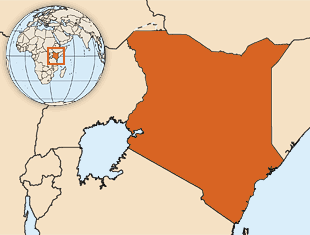  PROGRAMS & THEMES: Gender, IFIs and the Global Food Crisis
 Case Study:
Kenya
Download the case study (pdf, 888kb)
Approximately 10 percent of Kenya's population, or 3.8 million people, live in a chronic state of food insecurity (USDA, 2009), the most vulnerable of whom include women and children (Kimani-Murage, et al., 2011). Although women constitute 75 percent of Kenya's agricultural labor force, gender inequalities undermine their productivity, including limited access to essential resources (agricultural technologies, extension services and marketing facilities) and institutionalized barriers to credit and land ownership (Institute for Development Studies, 2006).
Today, Kenya is East Africa's largest importer of food and agricultural products (USDA, 2009) and faces an alarming rate of food insecurity in the wake of rising food prices. According to the World Food Program (WFP), the average Kenyan family spends almost half of household income on food (WFP, 2011). While several factors have contributed to Kenya's high rate of food insecurity, International Financial Institutions (IFIs), including the World Bank (WB) and African Development Bank (AfDB), have undermined agricultural development, contributed to the drastic rise in food prices and exacerbated rates of hunger and malnutrition. Starting with the WB and International Monetary Fund (IMF)'s Structural Adjustment Policies in the 1980s, Kenya experienced a crippling "absence of sustained
investment, limited scope for expanding into new lands and mismanagement of agricultural institutions" (Gitau, et al., 2008). Kenya's agricultural GDP plummeted as the WB and IMF "free market" policies and programs promoted
privatization and deregulation of commercial functions, as well as a reduction of trade barriers and exchange rate
adjustments (Gitau, et al., 2008). WB and IMF-imposed agricultural market liberalization ultimately benefited
"medium and large-scale commercial farmers, large-scale private traders, wholesalers and processors, and transporters
and other providers of market services" (Baden, 1998), the majority of whom are men. Meanwhile, these
policies devastated small-scale farmers engaged in processing and trading, the vast majority of whom are women
(Baden, 1998; FAO, 2011).
Gender Analysis Findings
This case study assesses the extent to which three WB and two AfDB projects meet their commitments to address
gender issues and promote gender equality in agriculture investments in Kenya. This qualitative assessment applies
Gender Action's Gender Toolkit for International Finance Watchers a user-friendly toolkit that helps civil society
groups incorporate gender perspectives into their work on IFIs and other projects—especially its Essential Gender
Checklist. The case study demonstrates that overall, WB and AfDB agriculture projects in Kenya lack a women's
rights perspective and pay inadequate attention to gender inequalities that hinder women and girls' ability to participate
in and benefit from project activities. Commendably, one project promotes gender integration, collects sexdisaggregated
data and facilitates women’s participation throughout the project cycle.
|
